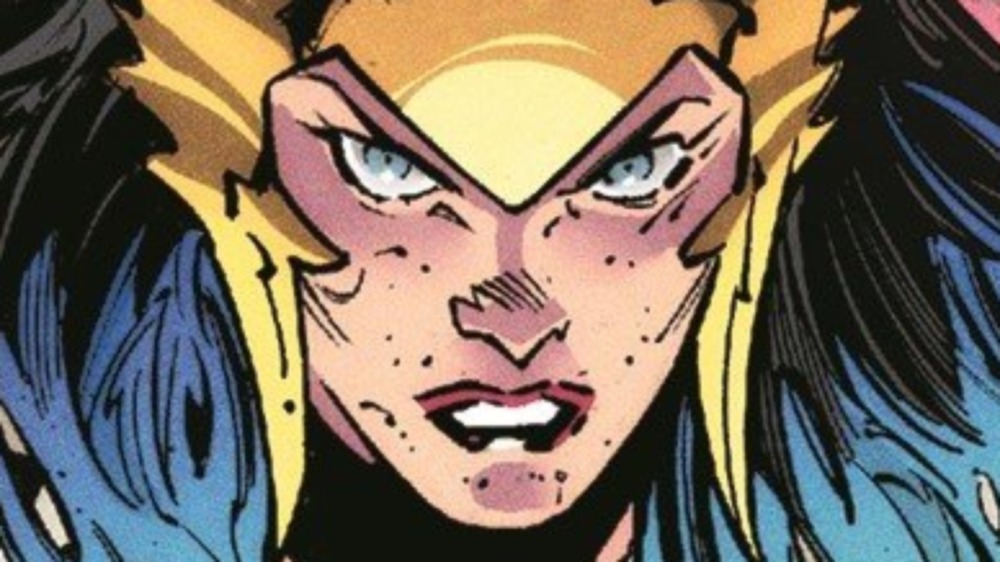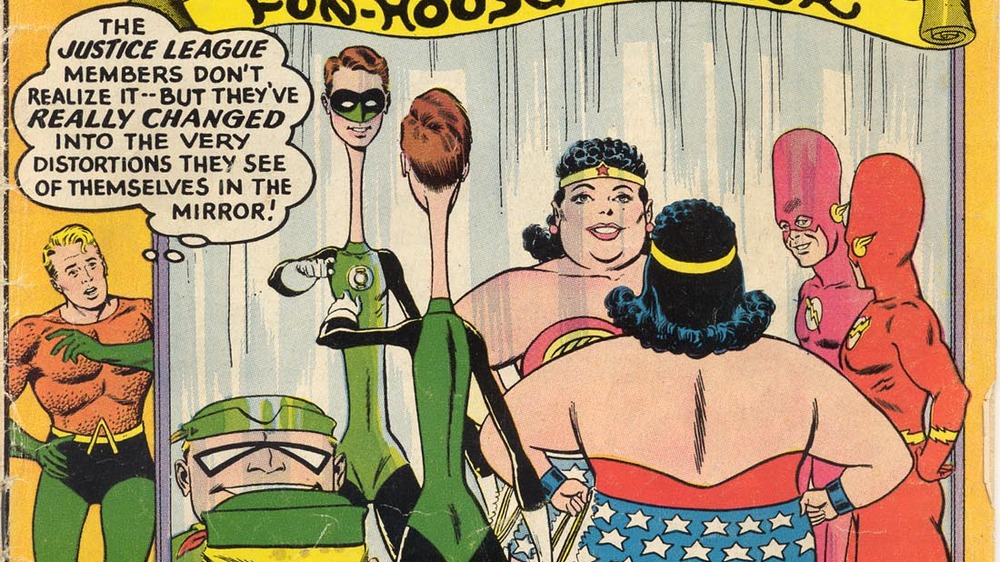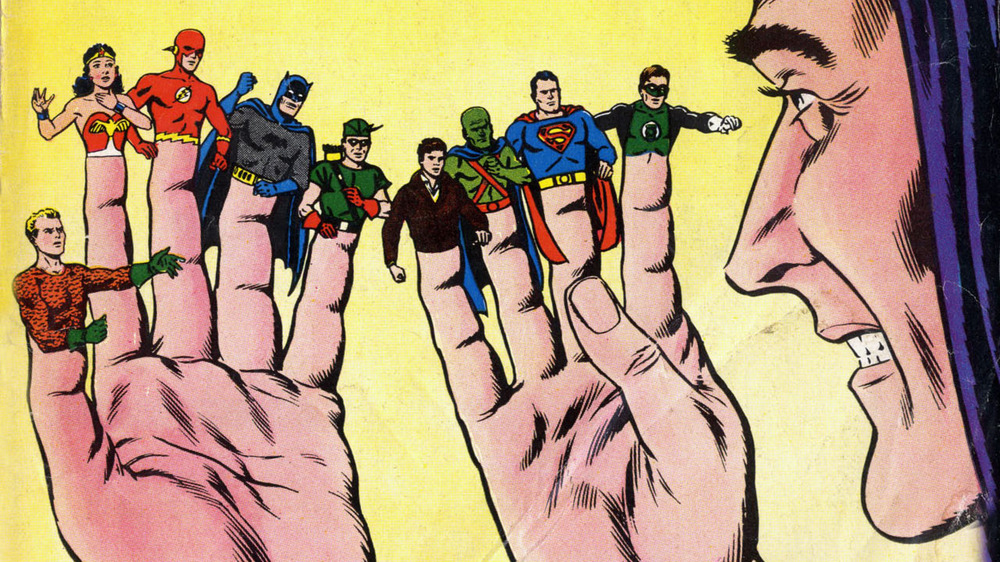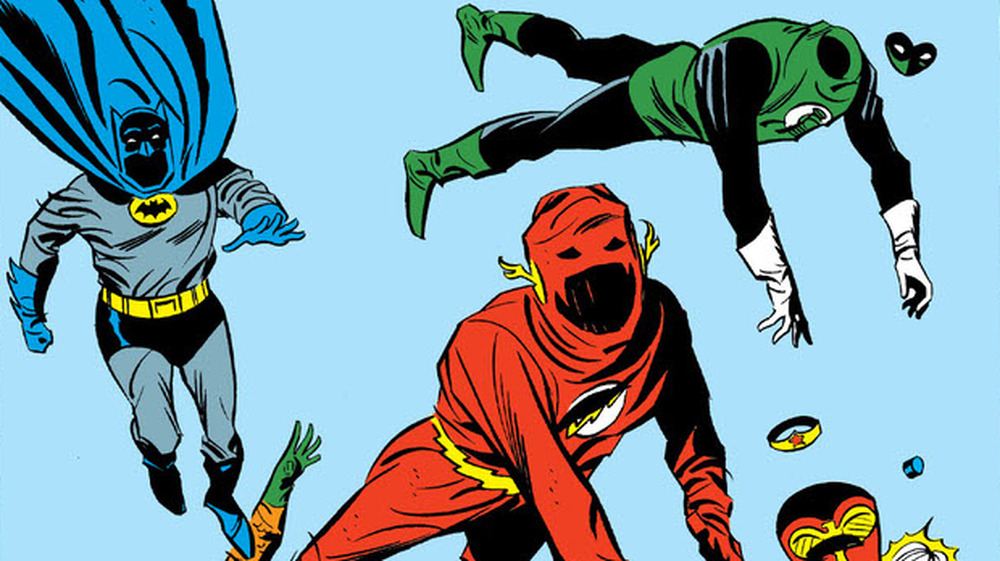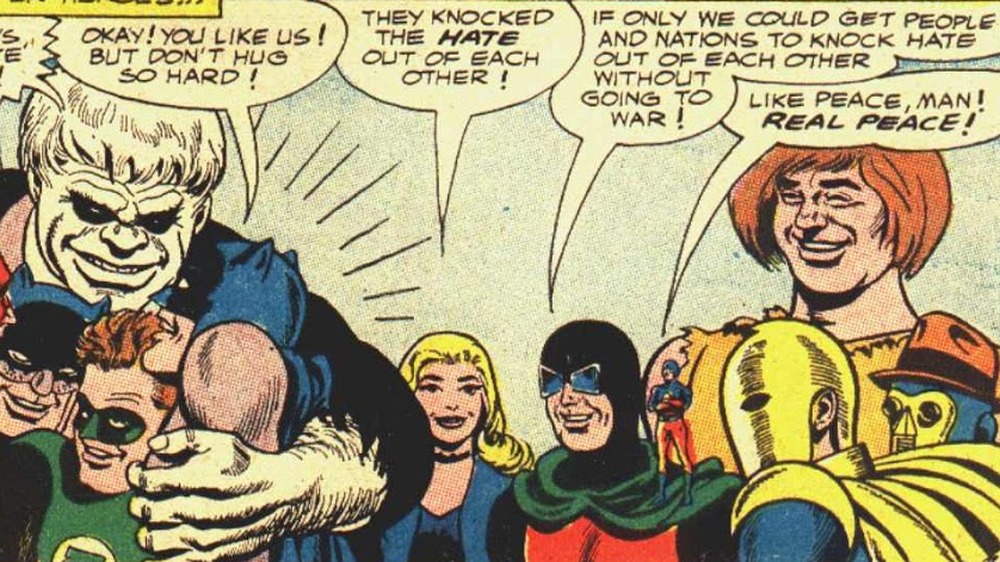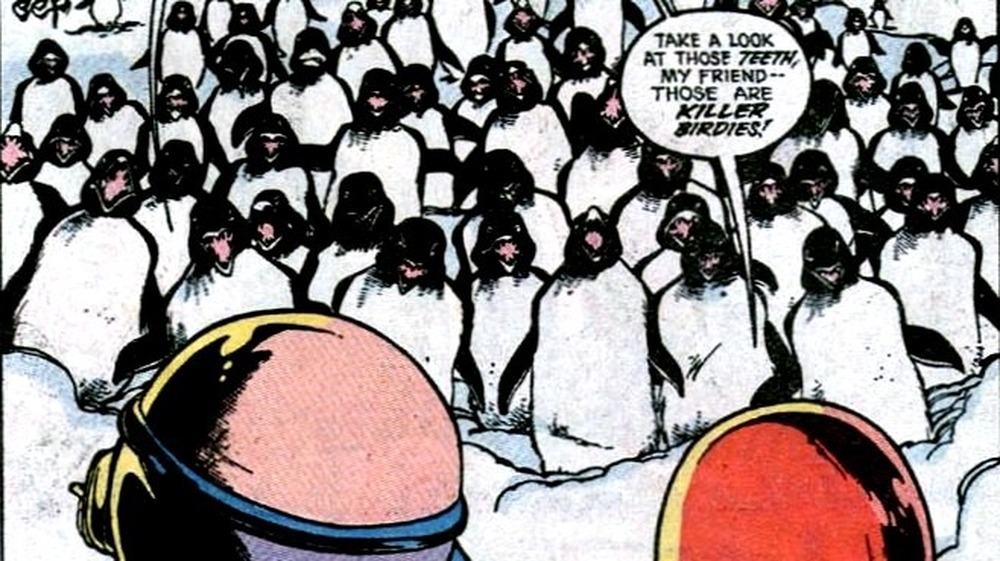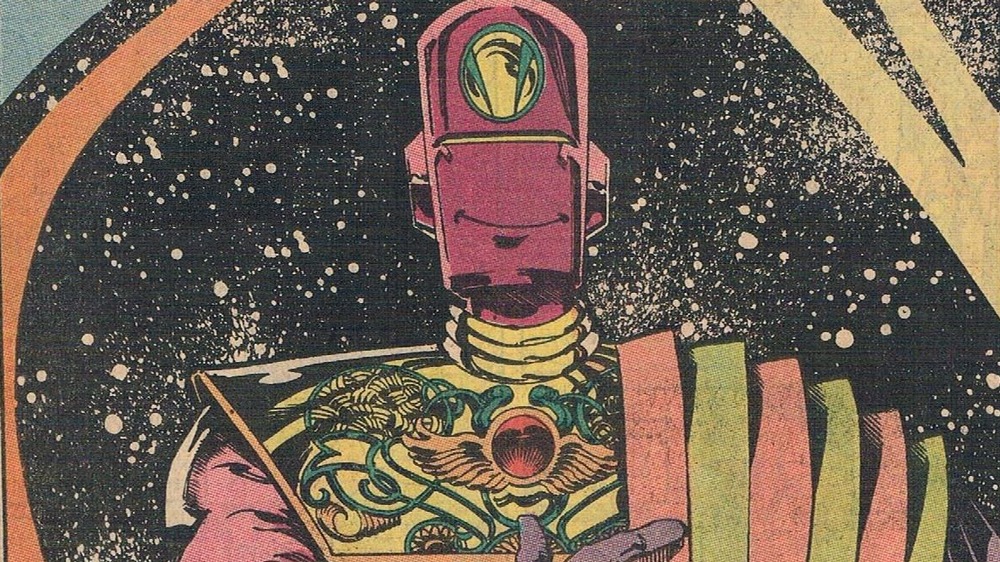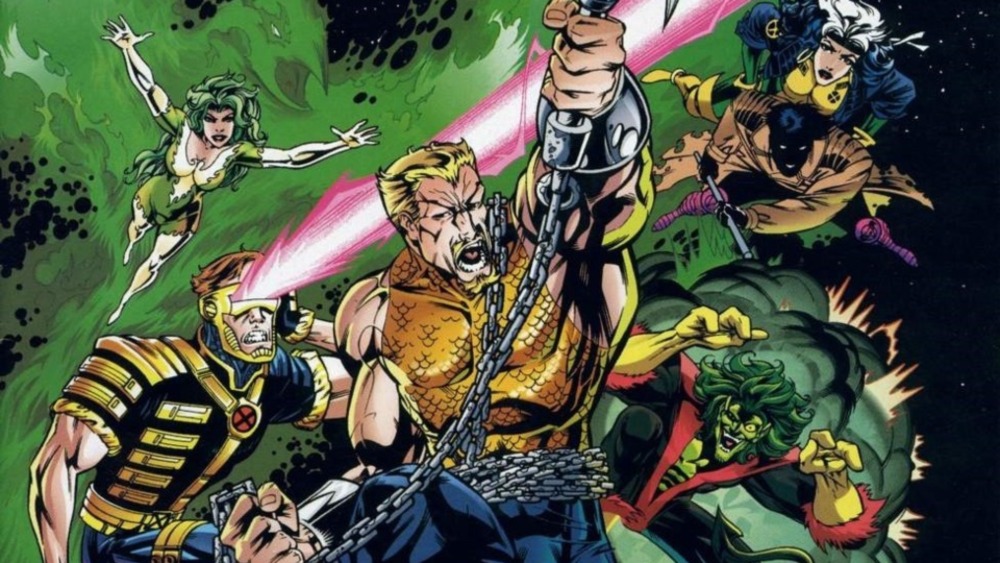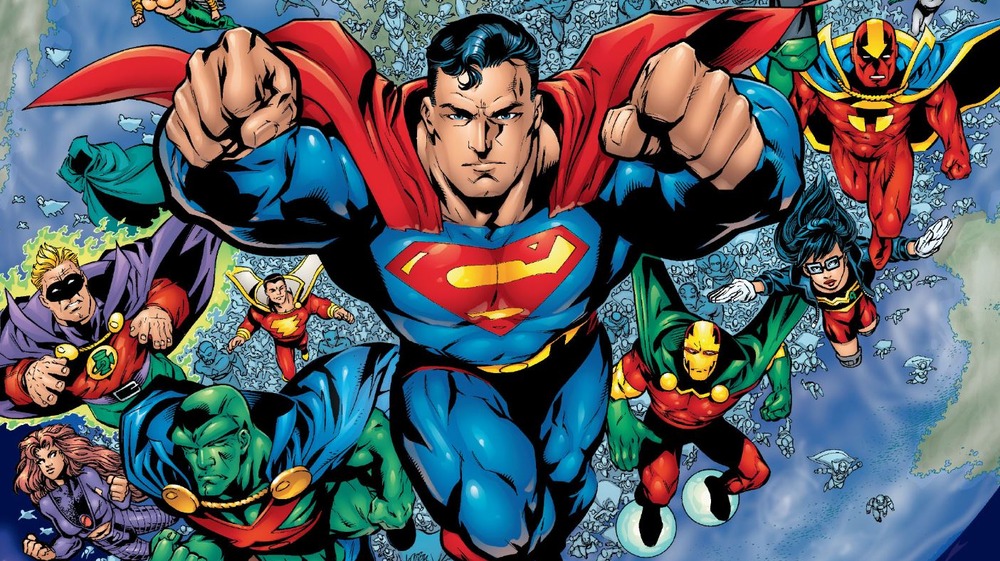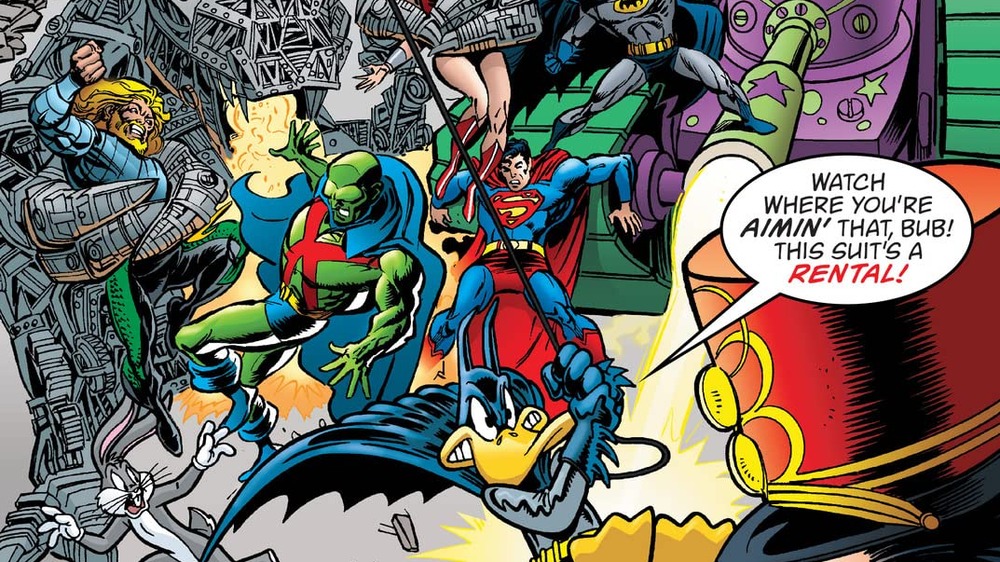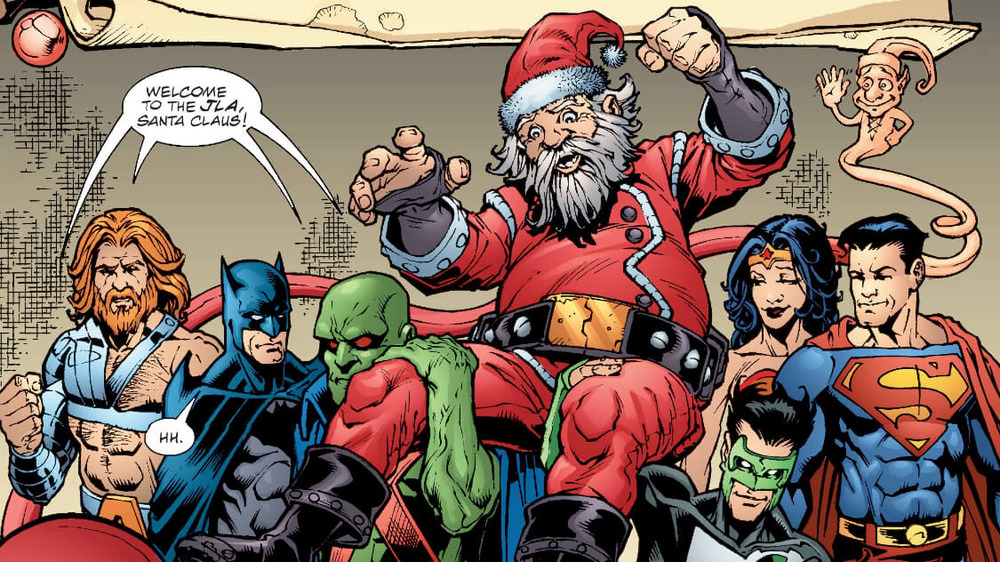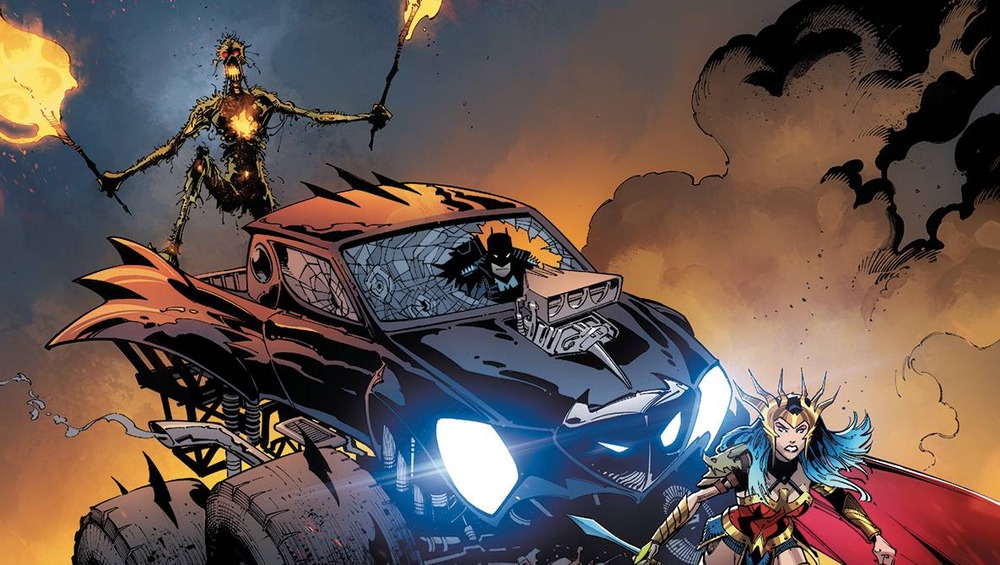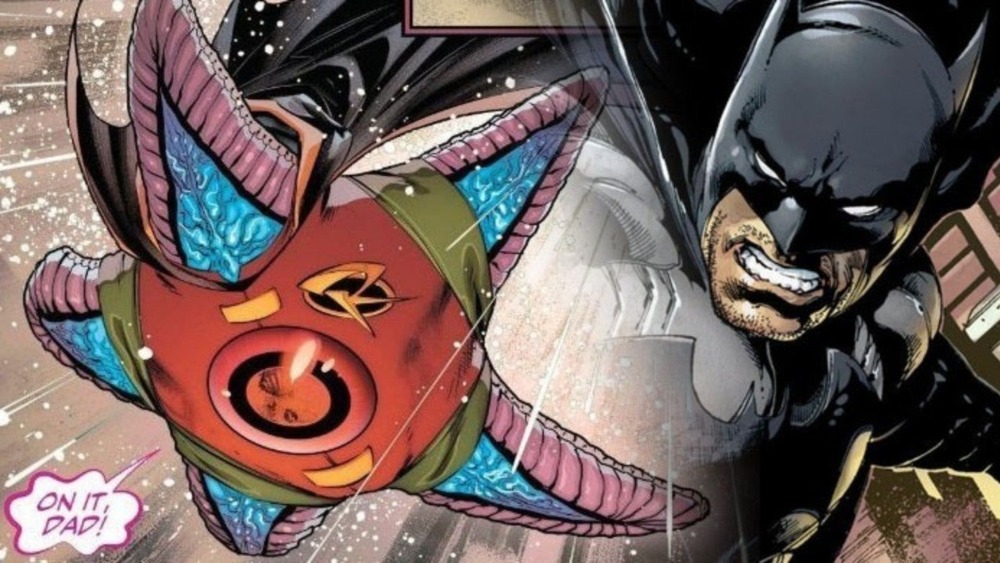The Weirdest Justice League Comic Book Stories Of All Time
Justice League began as a chance for readers to see comics' greatest heroes — Superman, Batman, Wonder Woman, etc. — all in one place. And the world's greatest comic book heroes deserve the world's greatest comic book stories, and hundreds of writers and artists have obliged, giving fans classic after classic with the team. And with shows like Justice League Unlimited and films like Zack Snyder's Justice League, their crime-fighting brand has grown even bigger.
In most media, a franchise this huge would come with heavy expectations and demands to soften anything unusual or off-putting that might cut down on the market share. But for good and for bad, comics are the red-headed stepchild of the mass media. And as every red-headed stepchild knows, the less attention you get, the more you can get away with.
That's the case with the Justice League comics, although we're not sure why. Maybe it's because meeting a deadline is more important than making any sense, or perhaps writers like Grant Morrison and Scott Snyder get free rein to write whatever weirdness pops into their heads because, after all, it's just a comic book. Regardless, Justice League has been fertile ground for some unforgettably strange stories. Here are just a few of the weirdest, wildest, and wackiest comics we could find.
The Justice League got lost in a cosmic funhouse
When the Justice League debuted in the '60s, DC Comics' strategy to pull readers was to throw whatever bizarre image they could think of on the cover. For example, take 1960's Justice League of America #7 by Gardner Fox and Mike Sekowsky. Before you open it up, you'll see the Justice League turned into literal funhouse mirror images of themselves, and the way the story gets there is even stranger than you'd expect.
A new funhouse opens up in the Justice League of America's (JLA) hometown of Happy Harbor, and the JLA's kid sidekick, Snapper Carr, is first in line. But the funhouse transports Snapper to another planet, so after rescuing him, the League decides to investigate. It all turns out to be a scheme by aliens to retrieve their lost probe because of course a cosmic funhouse is the most logical solution. They trap the JLA, who escape in an extremely convoluted way we won't waste your time explaining, except to say that the aliens let Green Lantern keep his power ring, so why didn't just use that to get out? Because he doesn't have enough "will power," apparently.
Then "mysterious cosmic forces pull their molecules out of alignment," which is all the explanation we get for that cover image.
Felix Faust controlled the Justice League with the power of finger puppets
The sorcerer Felix Faust and his demonic masters — Abnegazar, Rath, and Ghast — have become some of the Justice League's most popular enemies and some of the most serious threats they've ever faced. But the story that introduced them in 1960's JLA #10 was deeply, deeply silly.
In this tale, Faust helpfully explains that, like his literary namesake, he's looking for supernatural beings who will give him power in exchange for his soul. So he finds the three demons who've been imprisoned for almost a billion years in three ancient artifacts — the Red Jar of Calythos, the Green Bell of Uthool, and the Silver Wheel of Nyorlath. Their captors weren't messing around, and the demons decide the Justice League are the only ones who can retrieve the totems and free them.
How the demons do that is another story. They turn Faust's fingers into replicas of the Leaguers and tell him to touch each digit against a different object (for example, he touches a pomegranate with his Wonder Woman finger), complete with little cartoon "bonk" starbursts. What's the point of this? Well, once the real Leaguers touch their corresponding objects, the heroes come under Faust's power, but the connections get pretty tenuous. Wonder Woman gets hooked by a hand grenade because it's named after the Spanish word for "pomegranate," for instance.
There's still plenty more weirdness to come, especially in the ending, where Aquaman breaks Faust's spell by slapping him in the face with a school of flying fish!
The Justice League fought their own laundry
Thanks to Felix Faust's shenanigans, the demonic trio of Abnegazar, Rath, and Ghast escape their magical prisons ... before the Justice League tosses them in crypts created by the Green Lantern. Of course, in JLA #35, the demons attempt a new breakout. It turns out that in their last battle, the demons' "magical magnetism" rubbed off on the Justice League's costumes (sure, let's go with that), allowing the entities to control their clothes.
But that's still not enough, so the demons send the uniforms out to animate four other uniforms belonging to some supervillains so they can fight the JLA. The battle with these bad guys ends up shredding the Justice Leagues' clothes, forcing them to change into their demon-possessed duds. (Yes, the entire Justice League only has two copies of their everyday wear. The stink probably knocks out more bad guys than their fists.) Now, the demons can force them to summon a trio of magical totems in order to free them from their prisons. How can the good guys possibly win now?
By cheating, of course! With one page left, Green Lantern reveals he'd actually taken care of everything without ever letting us know, somehow telling the demon-freeing artifacts to reappear back in a vault if they were ever stolen and undo whatever mischief the demons caused. Green Lantern's superpower is apparently whatever the plot requires.
The Justice League got two bad guys to literally beat the hate out of each other
By the end of the '60s, Marvel Comics came from behind to threaten DC's dominance with their new, more self-aware brand of silliness, and the Batman TV show took that approach even further to become a bona fide cultural phenomenon.
JLA #46 made no secret of its inspiration, with a cover showing supervillains clobbering the Dark Knight and friends right through the big cartoon sound effects that were trademarks of the Batman show. And as for the goofy story, the parallel Earths of the Justice League and Justice Society are in chaos, with people from one suddenly appearing on the other, including the superpowered bruisers Solomon Grundy and Blockbuster. It's all the fault of the Antimatter Man, but fortunately, the Spectre manages to keep the two Earths from colliding by ... lying in between them. The JLA finds a more permanent solution in #47 when the Atom shrinks the Spectre and blows him back up again, which doesn't really seem like it should work, but hey, there are only a couple pages left, and there's still the Blockbuster/Grundy plot to wrap up.
So how does the comic wrap it up? Well, after one punch, Grundy and Blockbuster are suddenly best friends, and in the '60s-tastic ending, the heroes make some strange observations on peace and love and how these two "knocked the hate out of each other."
The world's worst supervillains started their own Justice League and fought killer penguins
When writers Keith Giffen and J.M. DeMatteis took over Justice League in 1987, they reimagined the book as a kind of hybrid superhero adventure and sitcom, focusing as much on the wacky antics of Booster Gold, Blue Beetle, and their teammates as earth-shattering threats. This meant reimagining the Injustice League too. Instead of the world's greatest villains, this incarnation teamed up the worlds' worst. In JLA Annual 1990, they meet in the unemployment office and decide to pull off one last heist. It turns out a terrorist cell has beaten them to it, and in the chaos, the Injustice League gets credit for "saving" their intended victims.
Major Disaster decides to parlay this strange turn of events into jobs with the Justice League, whose boss, Maxwell Lord, obliges them — but only so he can assign them to Antarctica and never have to worry about them again. While he's at it, he sends out G'Nort, a Green Lantern (he only got the job because his Uncle G'Newman pulled some strings with the Guardians of the Universe) who's too annoying even for this Justice League.
But it turns out there are some Justice League-worthy cases in the Antarctic when an experiment cross-breeding penguins and piranhas escapes from the local research base. Fortunately, the real Justice League shows up, but the Antarctic team still manages to do some damage — to both the penguins and each other.
The Justice League fought a cosmic interior decorator
Keith Giffen and J.M. DeMatteis' sense of humor meant they set their Justice League against a lot of seriously strange villains, but none were quite as odd as Mister Nebula. His story starts when JLA #36 introduces G'Nort's nemesis (as in, the only successful arrest he's ever made), the Scarlet Skier. A parody of Marvel's Silver Surfer, the Skier is also a herald for a planet-destroying being of unimaginable power: Mister Nebula. Unlike Galactus, though, Mister Nebula destroy planets not by consuming them but by redecorating them in the tackiest ways imaginable.
In Justice League Quarterly #2, Nebula arrives on Earth. The Skier also fills us in on the villain's history. Once he was an ordinary designer named Kirtan-Rodd, but then two Lords of Order were so horrified by the temple he built to them that they banished him to another dimension. But Kirtan escaped, and full of cosmic power, he made it his mission to spread gauche across the galaxy.
The Justice League heroes manage to (barely) save the world, proving weird problems require weird solutions. League member Ice knocks the giant out by climbing into his inner ear, and the Martian Manhunter finishes the job by convincing Mister Nebula his services are unnecessary because the designer has inspired the people of Earth to remodel the planet according to his standards already. For proof, Manhunter takes Mister Nebula to a city that lives up to all his dreams: Las Vegas.
The Justice League merged with the Avengers and X-Men
Comics are all about team-ups and crossovers because, deep down, we're all just like little kids arguing over whether Batman could beat Superman. But since most of the big names belong to two rival companies, we don't get to see the heroes of the Marvel and DC Universes together too often. When they do team up, it's a major event, never with more hype than 1996's DC vs. Marvel.
That ended with the two universes merged, leading to dozens of spinoffs under the Amalgam Comics label. The individual characters merged with each other too, and a whole bunch of the mashed-up heroes appeared in JLX and JLX Unleashed. This "metamutant" team originally belonged to the Judgment League Avengers until a few members split off to rescue their fellow mutant, the Mariner, from the League's custody.
Writers Gerard Jones and Mark Waid obviously had a lot of fun coming up with amalgamated heroes for JLX. Some highlights include Mr. X (secretly a Skrull whose true form looks an awful lot like the Martian Manunter), Sunfirestorm, Angelhawk, and inevitably, Captain Marvel (the two DC and Marvel heroes of the same name).
The Justice League gave everyone on Earth superpowers
When Grant Morrison, one of the weirdest writers in superhero comics, took on JLA, he brought along some of the same strange flair that made his Doom Patrol and Animal Man such big hits. For example, in 1997's JLA #37, the team barely manages to stop a superpowered prison riot caused by a giant eyeball parasitically attached to the psychic prisoner Hector Hammond. The New God Orion recognizes this creature as Mageddon, the star-sized psychological weapon that destroyed the Old Gods.
Needless to say, this Mageddon turns out to be a major problem. After all, back in JLA #36, Wonder Woman discovered the ruins of Wonderworld, a planet populated by the world's most powerful, godlike heroes who devoted their lives to protecting the universe from Mageddon ... but the beast wiped the place out in moments. As if that wasn't bad enough, the new Injustice League has the JLA on the ropes, all while Mageddon's influence causes war to break out all over the Earth.
The only way to save humanity is to use the Amazons' healing purple ray, powered by the last survivor of Wonderworld, to give everyone on Earth superpowers, and the whole planet joins forces to finally defeat Mageddon.
Bugs and Daffy helped the Justice League save the Earth from an interdimensional dodo
Mark Evanier and Joe Staton's 2000 miniseries Superman & Bugs Bunny brought all the wackiness of Looney Tunes into the DC Universe, with some help from its looniest resident — the unpronounceable, fifth-dimensional prankster Mr. Mxyzptlk. Meanwhile, Bugs Bunny is dealing with his own otherworldly visitor, the Dodo from Porky in Wackyland.
The two sprites crash into each other on their way back to their home dimensions, and when Mxyzptlk learns there are no superheroes in the Looneyverse, he decides it'd be a good idea to try and prank it for a change. He quickly learns the error of his ways when he finds out everyone there is at least as tricky as he is, but he and the Dodo hatch a new, improved plan to send the Looney Tunes characters into the DC Universe, leading to bizarre scenes like Speedy Gonzales and the Road Runner outrunning the Flash.
In #2, Mxyzptlk and the Dodo go even further, forcing Superman and Elmer Fudd to switch places, and then in #3, the Dodo switches Batman and Daffy Duck. Then, the Dodo reveals this is more than just fun and games to him. He wants to merge the two universes, permanently. Fortunately, the Justice League arrives in time to save the day — with some help from a wascally wabbit.
The Justice League made Santa Claus a member
This one technically isn't canon since it's just a story Plastic Man makes up to entertain Woozy Wink's nephew. But since all these stories were made up by their writers to entertain us, we figure it counts as much as any of them.
In 1997's JLA #60 by Mark Waid and Cliff Rathburn, Plastic Man discovers the tyke thinks Santa isn't as cool as the JLA, and the hero accidentally tells him Santa's his teammate. That leads to a whole story that opens with an image of the Justice League welcoming Santa Claus into their ranks, except for Batman, who's apparently not impressed.
Plastic Man's story also involves the demon Neron and his butt-ugly "little helpers," who give presents to children for being bad, trap Kris Kringle in a life-sized action figure box, and turn the Justice League into coal. Fortunately, Santa escapes with his heat vision ("Santa Claus has heat vision?") and defeats Neron (by giving him socks and underwear).
Woozy's nephew doesn't believe the story ... until he sees Santa flying by on a jetpack and writing "Merry Christmas" in the snow with his heat vision. Could Santa be real? Well, it turns out this was just the shapeshifting Martian Manhunter ... but the real Santa does show up in the last panel.
An army of evil Batmen turned the multiverse into a heavy metal album cover
Scott Snyder began his run on Justice League with artist Greg Capullo on the Dark Nights: Metal miniseries, where twisted Batmen calling themselves the Dark Knights came from the Dark Multiverse to drag all the other Earths down with them. At the time, it was the wildest thing Justice League fans had ever seen, but once Snyder took over the main book, he topped himself with every new issue, building his epic story of the League fighting to save the multiverse from its own creator, Perpetua.
It all comes to a head in Justice/Doom War, which ends with Perpetua victorious, paving the way for the Dark Knights to return in Dark Nights: Death Metal and turn what's left of the multiverse into a heavy metal wasteland. Here are just a few of the things you'll find in that miniseries. Wonder Woman melts down her invisible jet to make a Chainsaw of Truth. We get a Batman who's merged his consciousness with Gotham City, as well as a dinosaur Batman, a motorcycle made out of a bat skeleton, and a living Batmobile, reinvented as a Mad Max muscle car. Harley Quinn rides a giant hyena like a horse, we see a Cthulhu-Batman, and we watch our Batman carry a scythe and raise an army of the dead. And that's just for starters.
A baby starfish helped the Justice League save the multiverse
One of the strangest additions in Scott Snyder's run is Batman's new sidekick, Jarro. He comes from the tissue of the alien supervillain Starro the Conqueror, who sacrifices himself to save the universe in Justice League: No Justice #3. But just like a real starfish, Starro can regenerate from a tissue sample, and Batman saves some in a jar. It grows into a new Starro, who the Caped Crusader naturally names Jarro.
Jarro's "father" may have been a villain, but he takes his role as a hero seriously. He calls Batman "dad," devotes himself to becoming his "favorite Robin ever," and even makes himself a little starfish-sized Robin suit. In Justice League #29, his bio-dad's evil ways come back out when Jarro "saves" his teammates by psychically controlling them so they won't make a potentially fatal attack on their enemies. However, his mental powers turn out to be essential to good's triumph over evil, as he hides the Justice League from the villainous Dark Knights. But he's still a weird little character, so much so that even Snyder himself can only say this when Jonah Hex tries to figure out why Batman's hugging a starfish: "See Justice League for why Batman is hugging a starfish. Or better yet, just make up your own reason."
